![Filipino salad with tinawon rice]()
For the sautéed shrimp paste dressing, heat the oil in a wok over medium heat. Add the garlic and onions and cook for 5-6 minutes or until soft. Add the pork, and cook, stirring continuously, for 5 minutes or until cooked. Add the tomatoes and cook for a further 5 minutes or until mushy. Add the fermented shrimp paste, reduce the heat to low and stir for 5 minutes. Stir in the sugar, remove from the heat and cool to room temperature.
For the peanut sauce, heat the oil in a wok over medium heat. Fry the peanuts until golden. Remove with a slotted spoon and drain on paper towel. Once cool, grind the peanuts in a mortar and pestle or electric blender until finely chopped. Crush the garlic, eschallots and shrimp paste in a mortar and pestle until smooth. When the oil is safe to move, remove all but 1 teaspoon from the wok and place over medium heat. When hot, add the garlic and shrimp mixture and stir for 2 minutes or until fragrant. Add the chilli, sugar, soy sauce, tamarind water, 500ml (2 cups) water and peanuts and bring to the boil. Reduce heat to low and simmer for 8-10 minutes or until the sauce has thickened. Remove from heat and serve warm.
Steam the okra, sweet potato tops and kang kung for 3 minutes, then plunge into ice water to refresh and drain.
Grill the eggplants over an open wood or coal fire until blackened and charred all over. When cool enough to handle, peel and discard blackened skin.
To serve, place all the vegetables and the egg on a large serving platter. Serve the sauces separately, for dipping.
Note To make tamarind water, place 50g tamarind paste in a heatproof bowl and pour over 150ml boiling water. Allow to cool, then mix together to combine well. Strain the mixture through a fine strainer, extracting as much liquid as possible, then discard the solids.
Even though most people use rice cookers nowadays, it's good to know a foolproof way of cooking rice without one. I have found that if you measure your middle finger, with most adults the distance between the first joint and the end of the finger is relatively the same. This first joint is your very portable water gauge.
Take the amount of raw rice you require and wash it thoroughly in cool water only once.
Rice is so highly polished these days that if you wash it any more you will wash away any goodness left. If you are cooking this in Asia then it may need to wash two or three times, depending on where you bought it and how well the rice has been husked. You may also have to remove any stones or other foreign matter that has found its way into your rice.
Now, flatten the washed rice in the bottom of a large pot and add water until it reaches from the top of the rice to the first joint of your middle finger. For brown rice, add a little more.
Bring this to the boil, uncovered and salted, and cook on a high heat until you can see the top of the rice and the water has evaporated to that level. Turn the stove to your lowest setting. If you are using electric cookers, then have the hot plate next to it on the lowest setting ready to go, and transfer it, covered, to steam for about 10 minutes. Do not stir it or open the lid, as it will naturally steam and cook the rice so it's fluffy and dry.
Once cooked, remove the lid and, using the handle of a wooden spoon, fluff the rice and cover it until you need it.
Note Kang Kung, also known as water spinach, is a leafy vegetable readily available from Asian grocers. The leaves have a mild flavour and add a vibrant green colour to dishes.
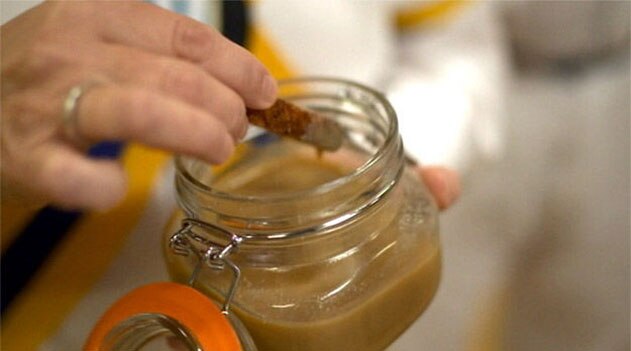 Heston: "Milk jam, or dulce de leche as it’s more commonly known, is made by slowly heating milk and sugar until it forms a jam-like consistency and soft caramel flavour. It can be made without the potato skins but they add an interesting roast potato flavour."
Heston: "Milk jam, or dulce de leche as it’s more commonly known, is made by slowly heating milk and sugar until it forms a jam-like consistency and soft caramel flavour. It can be made without the potato skins but they add an interesting roast potato flavour."
 Heston: "Milk jam, or dulce de leche as it’s more commonly known, is made by slowly heating milk and sugar until it forms a jam-like consistency and soft caramel flavour. It can be made without the potato skins but they add an interesting roast potato flavour."
Heston: "Milk jam, or dulce de leche as it’s more commonly known, is made by slowly heating milk and sugar until it forms a jam-like consistency and soft caramel flavour. It can be made without the potato skins but they add an interesting roast potato flavour."
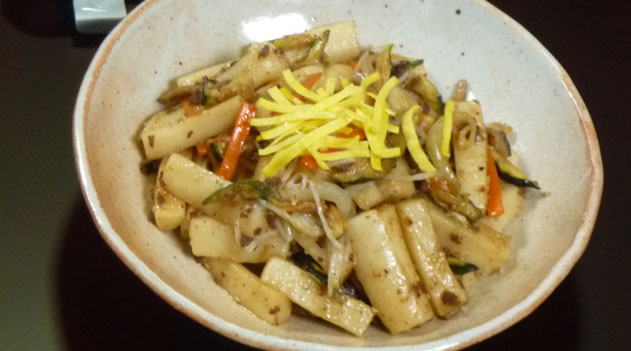 There are two kinds of stir-fried rice cake recipes: chilli-paste based, and soy sauce based. Long ago, the latter variety was exclusively prepared for Korean royalty. Also, bean sprouts, which are thought to reduce a fever, were often used in Korean royal cuisine.
There are two kinds of stir-fried rice cake recipes: chilli-paste based, and soy sauce based. Long ago, the latter variety was exclusively prepared for Korean royalty. Also, bean sprouts, which are thought to reduce a fever, were often used in Korean royal cuisine.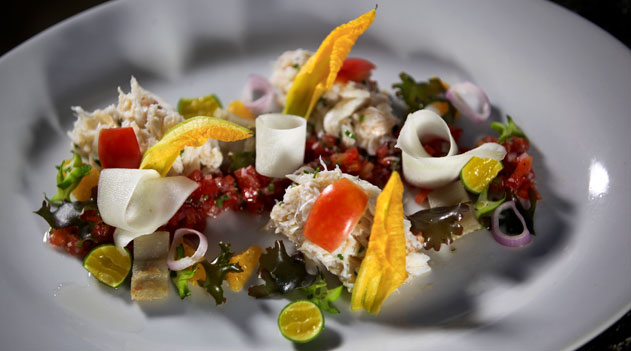 For the spanner crab salad, combine all the ingredients in a bowl. Refrigerate until needed.
For the spanner crab salad, combine all the ingredients in a bowl. Refrigerate until needed.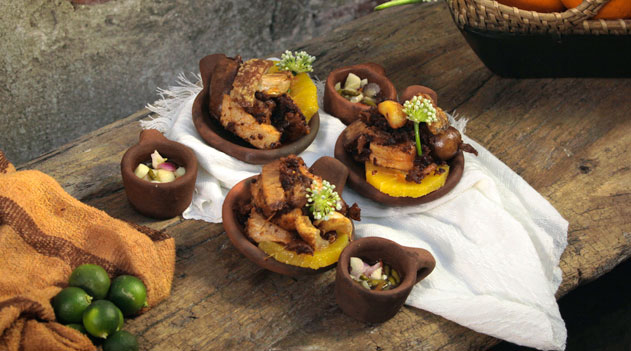 Place the torn bread into a sealable container. Add a pinch of salt. Pour 125ml (½ cup) water over the bread. Cover and shake, then refrigerate overnight.
Place the torn bread into a sealable container. Add a pinch of salt. Pour 125ml (½ cup) water over the bread. Cover and shake, then refrigerate overnight. 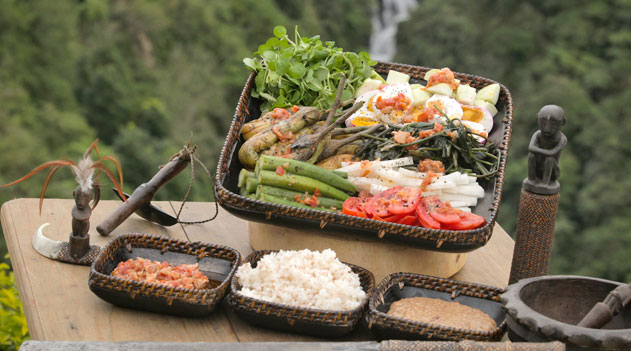 For the sautéed shrimp paste dressing, heat the oil in a wok over medium heat. Add the garlic and onions and cook for 5-6 minutes or until soft. Add the pork, and cook, stirring continuously, for 5 minutes or until cooked. Add the tomatoes and cook for a further 5 minutes or until mushy. Add the fermented shrimp paste, reduce the heat to low and stir for 5 minutes. Stir in the sugar, remove from the heat and cool to room temperature.
For the sautéed shrimp paste dressing, heat the oil in a wok over medium heat. Add the garlic and onions and cook for 5-6 minutes or until soft. Add the pork, and cook, stirring continuously, for 5 minutes or until cooked. Add the tomatoes and cook for a further 5 minutes or until mushy. Add the fermented shrimp paste, reduce the heat to low and stir for 5 minutes. Stir in the sugar, remove from the heat and cool to room temperature. 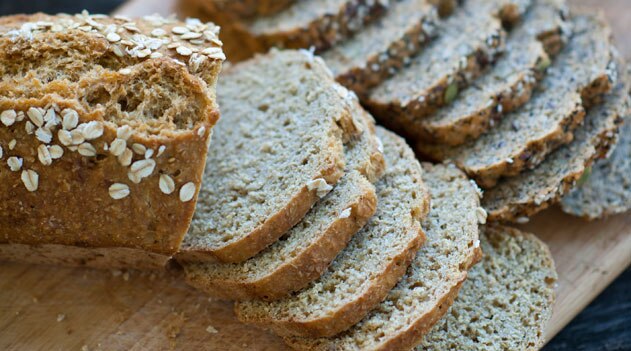 Preheat oven to 180°C. Place flours, bicarbonate of soda and ½ tsp salt in a bowl. Make a well in the centre, pour in 400ml buttermilk and stir until combined. Add enough of the remaining 200ml buttermilk until mixture resembles thick porridge.
Preheat oven to 180°C. Place flours, bicarbonate of soda and ½ tsp salt in a bowl. Make a well in the centre, pour in 400ml buttermilk and stir until combined. Add enough of the remaining 200ml buttermilk until mixture resembles thick porridge.  To make the coconut cream, combine all ingredients in a saucepan over medium heat. Cook, stirring, for 5 minutes or until starting to thicken; don’t allow mixture to boil. Remove from heat, cover surface with plastic wrap and set aside.
To make the coconut cream, combine all ingredients in a saucepan over medium heat. Cook, stirring, for 5 minutes or until starting to thicken; don’t allow mixture to boil. Remove from heat, cover surface with plastic wrap and set aside.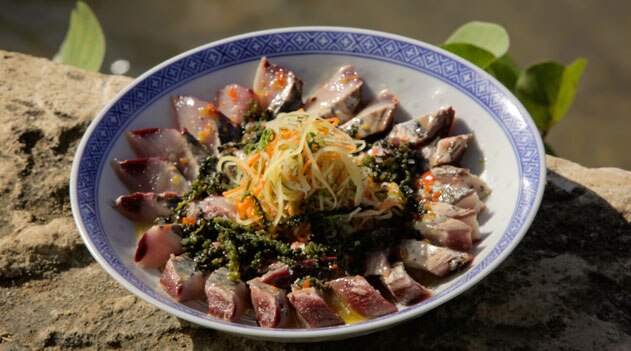 Place the fish, skin-side up, on an oven tray and place a lightly oiled cake rack on top of the fish. Using a domestic blowtorch, sear the skin for 10 seconds or until the skin has been just marked. Remove the cake rack and refrigerate the fish until needed.
Place the fish, skin-side up, on an oven tray and place a lightly oiled cake rack on top of the fish. Using a domestic blowtorch, sear the skin for 10 seconds or until the skin has been just marked. Remove the cake rack and refrigerate the fish until needed. 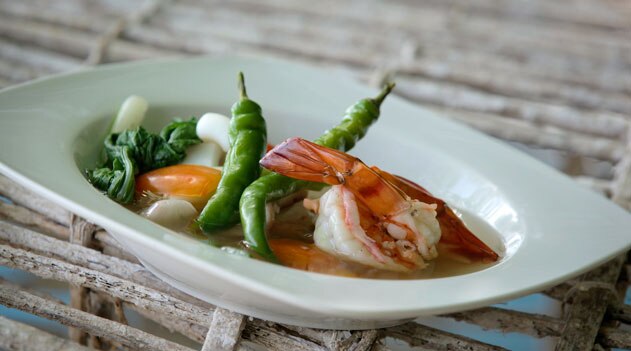 Wash the fish bones and place in a large saucepan with all the stock ingredients. Bring to the boil over high heat, then reduce heat to low and cook, skimming frequently, for 20 minutes.
Wash the fish bones and place in a large saucepan with all the stock ingredients. Bring to the boil over high heat, then reduce heat to low and cook, skimming frequently, for 20 minutes. 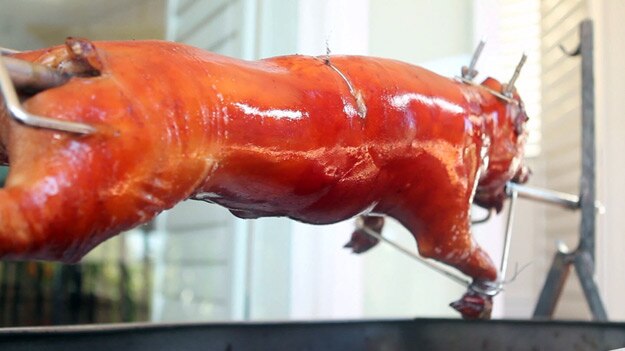 Spit-roasted suckling pig is always a crowd favourite at a party, but it's hard to perfect. A spit-roaster can be easily hired from a barbecue-hire service, found in most areas. They can supply you with all the utensils you’ll need, as well as the coals.
Spit-roasted suckling pig is always a crowd favourite at a party, but it's hard to perfect. A spit-roaster can be easily hired from a barbecue-hire service, found in most areas. They can supply you with all the utensils you’ll need, as well as the coals.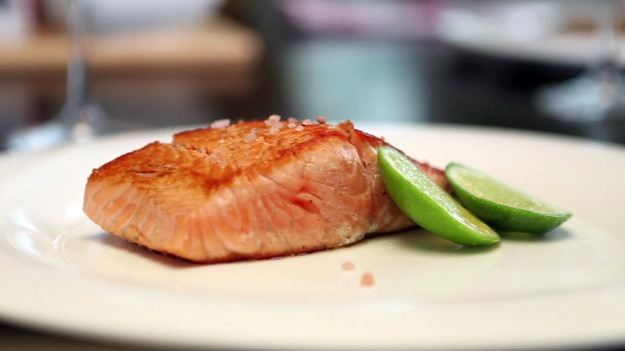 Salmon is one of the most popular species of fish in Australia at the moment, and there are so many different opinions on the best method of grilling. Follow the instructions below and you won’t be disappointed.
Salmon is one of the most popular species of fish in Australia at the moment, and there are so many different opinions on the best method of grilling. Follow the instructions below and you won’t be disappointed.
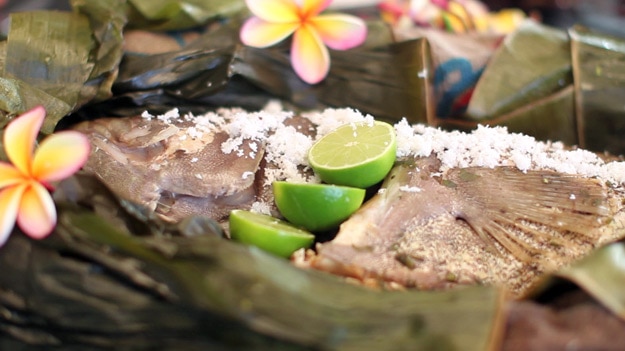 An umu (also known as a lovo or hāngi) is a popular traditional method of cooking throughout the Pacific Islands. This recipe will help you achieve the signature taste of umu-cooked fish in your home kitchen, without the need to dig up the backyard!
An umu (also known as a lovo or hāngi) is a popular traditional method of cooking throughout the Pacific Islands. This recipe will help you achieve the signature taste of umu-cooked fish in your home kitchen, without the need to dig up the backyard!
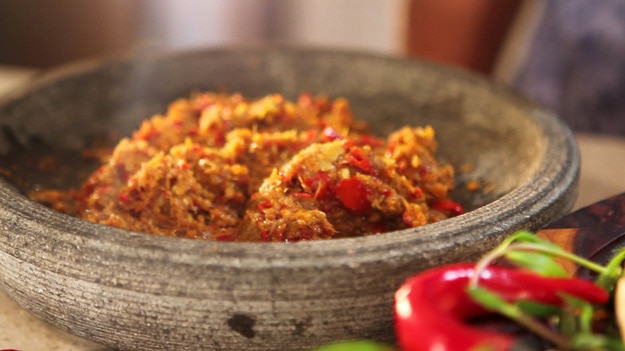 Sambal is such a versatile accompaniment and, when you try this
recipe, I’m sure you'll never use store-bought sambal again. Stored in
the fridge, this will keep for several weeks.
Sambal is such a versatile accompaniment and, when you try this
recipe, I’m sure you'll never use store-bought sambal again. Stored in
the fridge, this will keep for several weeks. Baking cakes is a much loved pastime for Dutch women – many of whom were taught the basics by their mothers. SBS Dutch Radio's Anneke Mackay-Smith’s mother was an excellent cook and made sure the knowledge was passed on. This pink berry roll was created with a girl’s birthday party in mind and is a modern take on an old family favourite. In this podcast, she recounts the recipe with fellow SBS producer Josine Tonen.
Baking cakes is a much loved pastime for Dutch women – many of whom were taught the basics by their mothers. SBS Dutch Radio's Anneke Mackay-Smith’s mother was an excellent cook and made sure the knowledge was passed on. This pink berry roll was created with a girl’s birthday party in mind and is a modern take on an old family favourite. In this podcast, she recounts the recipe with fellow SBS producer Josine Tonen.
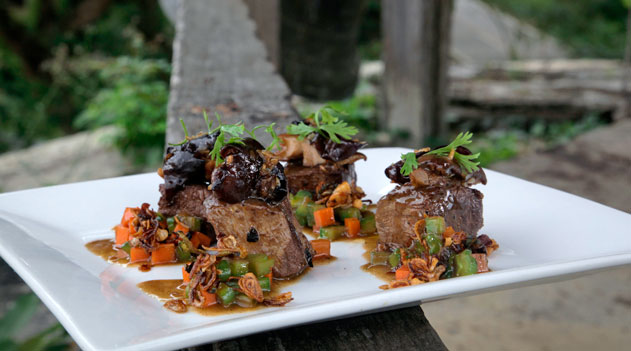 Preheat the oven to 140°C.
Preheat the oven to 140°C.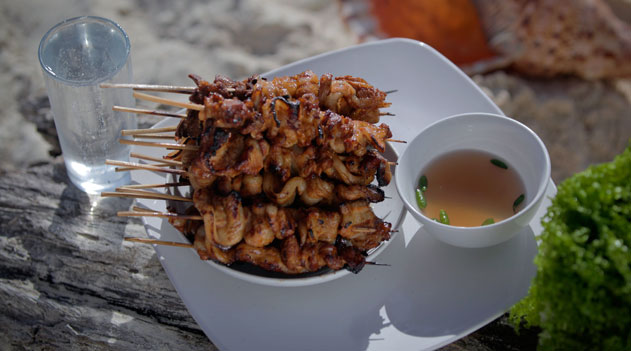 Cut the pork into long thin slices, about 5mm thick and 5cm wide.
Cut the pork into long thin slices, about 5mm thick and 5cm wide.  Divide the corn or chickpeas, sweet yams, jackfruit, mango, banana, coconut and jelly among 4 tall glasses. Top each glass with ½ cup shaved ice, 60ml (¼ cup) milk and 1 scoop of ice-cream. Sprinkle with peanuts and serve immediately.
Divide the corn or chickpeas, sweet yams, jackfruit, mango, banana, coconut and jelly among 4 tall glasses. Top each glass with ½ cup shaved ice, 60ml (¼ cup) milk and 1 scoop of ice-cream. Sprinkle with peanuts and serve immediately. 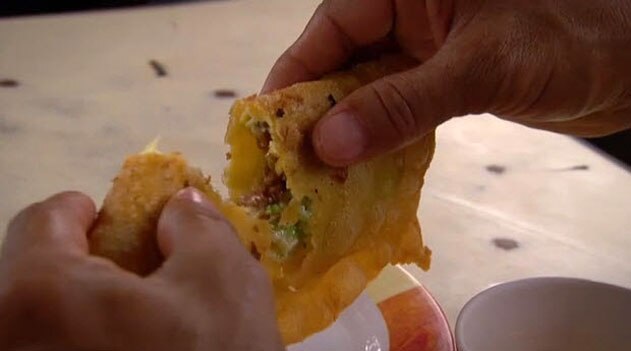 To make the dough, place the oil and annatto seeds in a small saucepan. Place over low heat until the oil is just warm. Remove from heat and set aside to stand for 20 minutes. Strain and discard the seeds. Allow the oil to come to room temperature.
To make the dough, place the oil and annatto seeds in a small saucepan. Place over low heat until the oil is just warm. Remove from heat and set aside to stand for 20 minutes. Strain and discard the seeds. Allow the oil to come to room temperature.  This Middle Eastern salad makes the most of fresh, seasonal vegetables and leftover pita bread. As fattoush is eaten in a number of countries, including Lebanon, Syria, Egypt and Israel, there are many variations on the dish. Our recipe is closest to a traditional Lebanese version.
This Middle Eastern salad makes the most of fresh, seasonal vegetables and leftover pita bread. As fattoush is eaten in a number of countries, including Lebanon, Syria, Egypt and Israel, there are many variations on the dish. Our recipe is closest to a traditional Lebanese version.